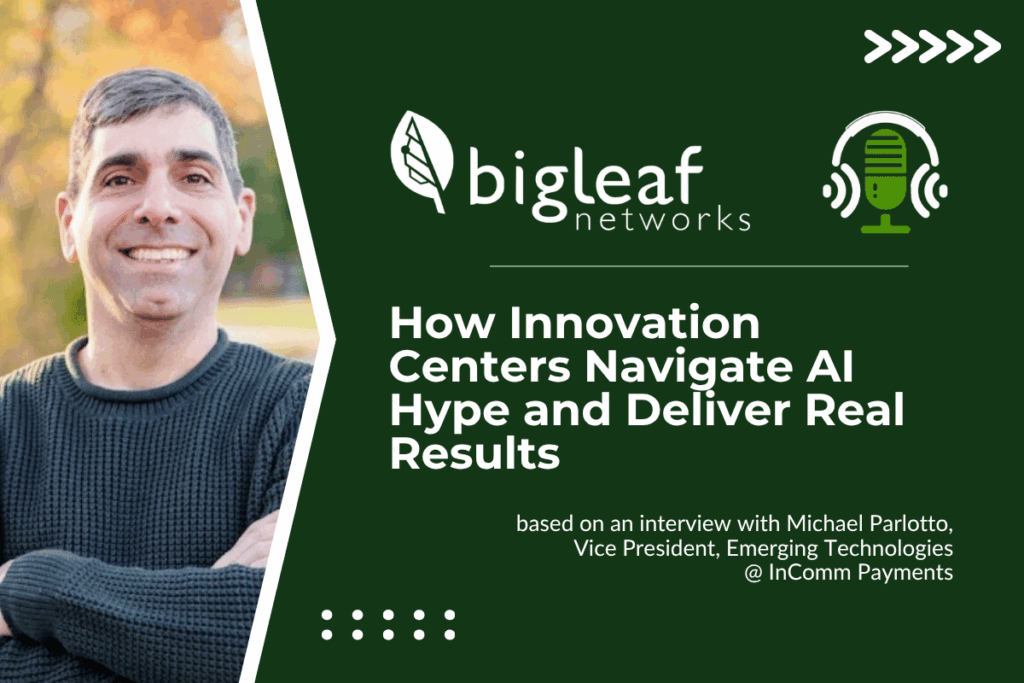Turning AI into ROI starts long before model training—it begins with clarity. Michael Parlotto, Vice President of Emerging Technologies at InComm Payments, shares a disciplined approach that helps organizations align bold ideas with measurable outcomes. His framework—problem framing, design thinking, and futures scanning—creates alignment from the first conversation through long-term delivery.
From Concept to Clarity
Innovation often falters because teams rush to tools instead of framing the real problem. Michael’s team flips that script.
“Specifically for our team, for the innovation center, the customer focus is our number one priority, and right from the beginning it was a pillar of all the work that we were doing.”
By defining the problem first, teams uncover constraints that would otherwise derail progress. “We use a framework called problem framing… you can get to what the root problem is, and then you can prioritize that list of problems to get to the ones that are really the big bets.”
Problem framing isn’t theory—it’s structure. It forces clarity around which issues truly move customer satisfaction and business results, creating alignment across engineering, product, and leadership.
Prototype Fast, Learn Faster
Once clarity is reached, speed matters. “Then it goes from there into design thinking, which is an industry standard framework for solving whatever that problem is, coming up with ideas.” Michael’s team builds low-fidelity prototypes—sketches, paper models, even makeshift mockups—to validate assumptions before investing heavily.
These early iterations invite customer feedback and reduce waste. “We start creating very low-fidelity proofs of concept… It might be using swizzle sticks and lollipops and spaghetti to develop whatever that proof of concept is.”
By testing quickly and adjusting often, innovation stays agile without losing focus.
Future-Proof Your Launch
Innovation doesn’t end at release. Michael’s final step prepares teams to protect their wins. “We’ve developed a futures framework… It’s not a crystal ball, but it points out signals that can allude to where the future could be going.”
By tracking regulatory, technical, or behavioral shifts early, organizations can reinforce products before disruption hits. Futures scanning transforms hindsight into foresight—ensuring success continues after the first rollout.
Key Takeaways
- Define problems clearly before investing in tools.
- Use design thinking to iterate quickly with real users.
- Apply futures scanning to defend products after launch.
- Connect innovation metrics to measurable business outcomes.
- Keep teams aligned on clarity, not complexity.
The ROI of Clarity
Problem-first innovation turns ambition into advantage. Michael Parlotto’s approach gives teams a structured way to translate ideas into impact—reducing rework, strengthening alignment, and proving results executives can measure.
Watch and Read
📖 Read the companion articles and more:
- Watch the episode and check out the podbook
- How Innovation Centers Navigate AI Hype and Deliver Real Results
- Delivering AI on Resilient, Secure Networks
Go Beyond:
- Watch the YouTube Playlist of video episodes
- Watch the YouTube Shorts Playlist
- Subscribe to the LinkedIn Newsletter
- Listen on Captivate: Go Beyond the Connection
- Follow us on social: Linkedin | Facebook | Instagram
- Learn more about Bigleaf Networks
